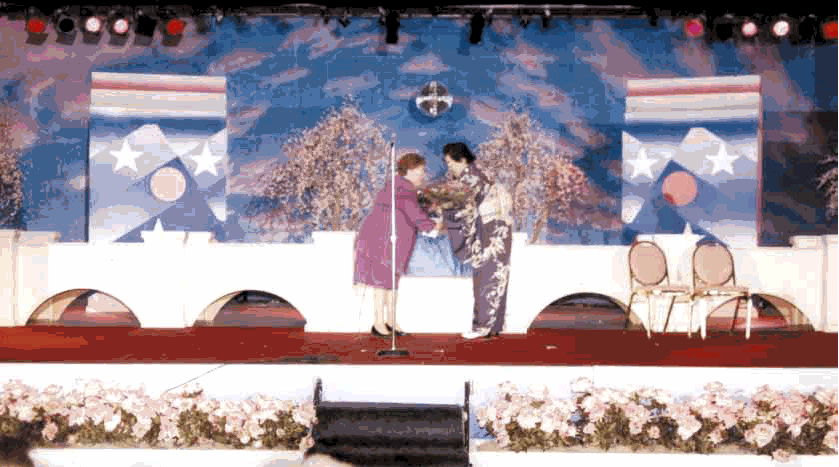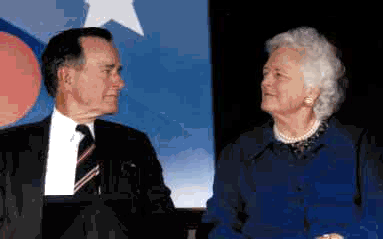
40 Years in America

|
|
40 Years in America |
|
Sisterhood Ceremonies

American and Japanese WFWP presidents, Mrs. Nora Spurgin and Mrs. Motoko Sugiyama, cross the "Bridge of Peace."
The second prong of the movementís three-fold approach to world peace and unification was that of forgiveness and reconciliation. Some issues simply transcended the problem-solving capacity of rational discourse and social idealism. Among the most serious global problems in the 1990s were the vicious hatreds among ethnic, national, racial and religious groupings. These, in fact, became more pronounced during the post-Cold War period when they were no longer held in check by the competing superpowers. Tutsis and Hutus killed one another in Rwanda; Croats, Serbs and Muslims killed one another in Bosnia; Irish and English killed one another in Northern Ireland and elsewhere; Jews and Arabs killed one another in the Middle East. Additional examples of this could be cited throughout the globe. Any program for peace, therefore, needed to go beyond the normal bounds of interpersonal relations and address issues of forgiveness and reconciliation, especially between enemies and former adversaries.
Here, the movement took its cue from the experience of Rev. Moon. During the cold war, Rev. Moon was widely regarded as a virulent anti-communist. However, it was less widely known that prior to the demise of communism, he sought reconciliation and developed personal relationships with Mikhail Gorbachev and the late North Korean leader, Kim Il Sung, both of whom had been serious adversaries in the past. In fact, both were alleged by the movement to have been linked to assassination plots against him. Rev. Moon adopted a similar stance much earlier toward Japanese secret police who had tortured him for his underground activities during their occupation of Korea and whom he subsequently aided in escaping reprisals following Japanís World War II defeat.

Former U.S. President and First Lady, George and Barbara Bush at a WFWP conference
Out of these personal encounters, Rev. Moon derived the inspiration to pursue forgiveness and reconciliation on broader levels. He encouraged marriages between partners of formerly enemy states, created situations in which followers from adversary nations worked together, and sent them out as missionary teams to the field. During the mid-1990s, he pursued these measures in a more programmatic way, working with the Womenís Federation for World Peace (WFWP) to sponsor large-scale "Sisterhood Ceremonies," first between Korean and Japanese and then between Japanese and American women. Rev. Moon understood that women would play a leading role in fostering peace in the Completed Testament Age. This sentiment was echoed in a particularly strong way by Mrs. Moon in a congratulatory address to participants in a Korean-Japanese sisterhood ceremony. She stated,
[N]one of you were treated properly by men who did not know the original value with which women were created. In the existing order, which discriminates between men and women, you have had to endure much suffering. However, today, you are seeing the age of women that is now dawning for the first time in history.
If women, who make up half of mankind, cannot enjoy proper human rights, can we have a peaceful world? The mistaken mentality that discriminates against women must be changed. The role of women must be expanded and corrected within all areas of society in which discrimination against women exists -- including the spheres of politics, law and the economy.... A woman, as seen from the viewpoint of the ideal of creation, is not an assistant to a man, but must be a partner.... We women have the mission to correctly guide those men who have until now led history through power, and confused the order of love in their lives.
Under the auspices of WFWP, more than 200,000 Korean and Japanese women "came together to create sisterly ties" in thirty-eight separate occasions between March 11 and November 8, 1994.
Sisterhood ceremonies conducted in the United States between Japanese and American women did not achieve those kinds of numbers, primarily due to the geographical distance between the two nations. However, they may have had more impact due to the involvement of persons with exceedingly high public profiles, most notably, former President and First Lady George and Barbara Bush. Numerous other leaders of the highest rank and celebrities spoke or entertained at WFWP-sponsored sisterhood ceremonies in the U.S. They included former Department of Education Secretary and author of The Book of Virtues, William Bennet; Ambassador Jeanne Kirkpatrick; television personality Barbara Walters; former Congressman Jack Kemp; "Superman" actor Christopher Reeves; Coretta Scott King; well-known psychologist Dr. Joyce Brothers; Olympic swimmer Matt Biondi; Mrs. Norman Vincent Peale; Maureen Reagan; singers Shirley Jones, Jennifer Holliday, and Naomi Judd; and actress Phylicia Rashad. Taking part in the ceremonies, many were deeply touched and accepted additional invitations. The most prominent were President and Mrs. George Bush who accompanied and spoke in support of WFWP with Mrs. Moon on a six-city speaking tour in Japan.
Between January 22 and March 8, 1995, 4,000 Japanese women traveled to Washington, D.C. to be matched with an equal number of American women in eight separate sisterhood ceremonies. These were set to coincide with the commemoration of the 50th anniversary of the end of World War II, and each ceremony built up to a dramatic "bridge-crossing" during which "a representative group of the Japanese delegates crossed over a special bridge, met their American counterparts in the middle where each bowed, embraced the other, and then walked down together, hand in hand." One participant commented, "It is hard to fully describe how moving this simple ceremony was without witnessing it!" The rich background of cherry blossom trees and roses on stage undoubtedly contributed to the effect. Following the highly successful Washington, D.C. conferences, the movement sponsored Japanese-American sisterhood ceremonies in eight U.S. cities during the remainder of 1995, with several thousand more women from both countries participating. In 1996, the WFWP conducted a number of "African-American/Caucasian-American" ceremonies. These activities in America inspired Austrian-Croatian, Czech- German, Russian-German, Hungarian-Slovakian, and Italian-Slovakian sisterhood ceremonies conducted by WFWP chapters in Europe.
The movement did not limit its efforts on behalf of forgiveness and reconciliation to symbolic exchanges. Members also took on sacrificial lifestyles and voluntary suffering. Rev. Moon referred to this as going to the "zero" point. Whatever the terminology, the group most embodying this and through whom Rev. Moon attempted to work most directly in the 1990s were Japanese women. In much the same way as he provided opportunities and encouraged Mrs. Moon in her leadership of WFWP and world speaking tours, so he looked to elevate the spiritual consciousness and commitment of Japanese women. Utilizing messianic imagery, he called upon them to take on an "Eve" or motherís role in the world. Japan had been sacrificially funding movement activities for years. During the 1990s, the movement deployed thousands of Japanese women as missionary workers. Initially, 1,600 went out to the 160 countries in which the movement had missions, ten per nation. Later, some 4,000 Japanese women went out to countries in the Americas. At the end of the decade, most of these sisters were deployed in the United States, and Rev. Moon stated his intention of sending 20,000 more. Many of them left husbands and children behind. Their commitment was intended not only to augment movement activities but also to inspire sacrificial efforts in others.
Download entire page and pages related to it in ZIP format
Table of Contents
Information
Tparents Home